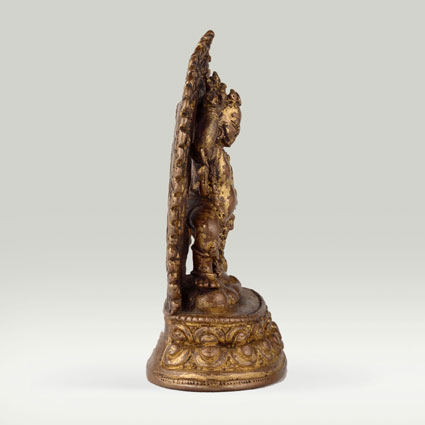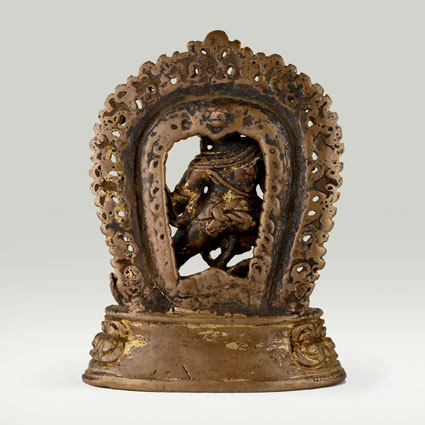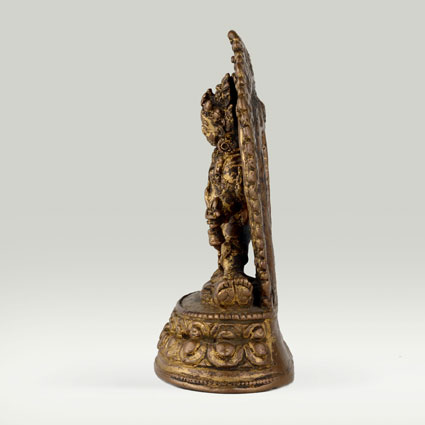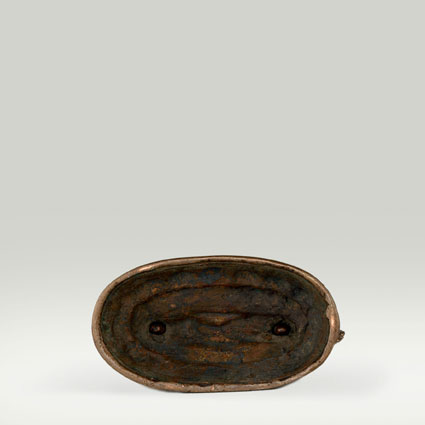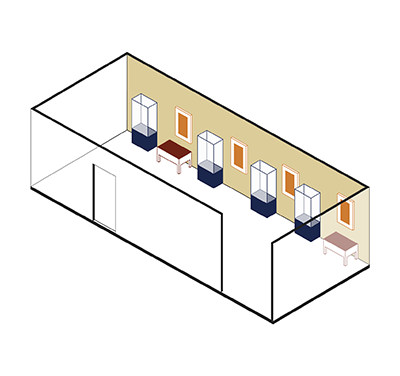
ABS 152
Code: ABS 152
Country: Nepal (west)
Style: Khasha Malla
Date: 1250 - 1350
Dimensions in cm WxHxD: 9.2 x 12.2 x 5.1
Materials: Gilt copper
(Tib. rDo rje rnam 'joms mting ga)
Partly hollow cast in one piece.
This tearsome form of Vajrapani knows as Nila-Vajravidarana (rDo rje rnam 'joms mting ga), is stepping to the right (pratyalidhasana) on a corps laid upon a double lotus pedestal. he brandishes in the right uplifted hand a five-pronged diamond sceptre (vajra) and holds in the left hand a prayer-bell (ghanta). Vajrapani is sparsely dressed. He wears ornaments at upper arms, wrists, ankles, feet, the "investiture with sacred thread composed of a snake" (nagopavita).
Khasya Malla Empire was ruled from their capital Semja. located in the Karnali River basin in Westwrn Nepal. their territory included Gu ge in Western Tibet, part of which they ruled from the 11th century until past the 14th century. In Western Tibet they succeeded the IDe family, which claimed descend from the kings of Lhasa, following the murder of gLang dar ma (838-842). Khasiya rulers with names ending in malla appeared only from about 1250 onwards and have to be distinguished from the Nepal Valley rulers with names also ending with malla. According to Tibetan sources, during the reign of Ripumalla, the Khasiya kingdom extended their territory to the South. The increased contacts with India resulted in an increased influence of Hinduism. During the earlier part of their reign, the Khasiya kings from Kracalla (1223 AD) to Pratapamalla had a greater bias for Buddhism. At the height of their power during the reign of Prthvimalla, the territory ruled over included Guge, Purang and large parts of modern Nepal.
Adhikary, Surya Mani, 1996. The Khasa Kingdom: A Trans-Himalayan Empire of the Middle Ages. Jaipur: Nirala Publ. Pp. 43-44; appendix A: pp. XII-XIII
Alsop, Ian, 1994. “The Metal Sculpture of the Khasa Malla Kingdom”, Orientations, Vol. 25, No. 6. Orientations. Vol. 25. No. 6. Pp. 61-68, 12 illus
Alsop, Ian, 1997. “Metal Sculpture of the Khasa Mallas”, Tibetan Art, edited by J. Casey Singer and P. Denwood. London: Laurence King Publ. Pp. 68-79, figs 50-60
Bock, Etienne; Falcombello, Jean-Marc; Jenny Magali, 2022. Trésors du Tibet. Sur les pas de Milarépa.. Paris: Flammarion. p. 143
Petech, Luciano, 1984. Medieval History of Nepal (c. 750-1480). Roma: Istituto Italiano per il Medio ed Estremo Oriente. Pp. 78, 107, 108
Ram, Rajendra, 1977. A History of Buddhism in Nepal (AD. 704-1396). Patna: Janabharati Prakasana. P. 187
Sharma, Prayagraj, 1972. Preliminary Study of the Art and Architecture of the Karnali Basin, West Nepal. Paris: C.N.R.S. P. 18
Shepherd Slusser, Mary, 1982. Nepal Mandala: A Cultural Study of the Kathmandu Valley. Princeton, New Jersey: Princeton University Press. Pp. 56, 228, 371
Tachikawa, Musachi et al. (eds.), 1991. The Ngor Mandalas of Tibet (NM) bSod nams rgya mtsho: Ngor collection of the 139 rGyud sde kun btus Mandalas), 2 Vols. Tokyo: The Centre for East Asian Cultural Studies. Mandala no. 18: 15 Deity Nila-Vidarana Mandala - References to the iconography of Nila-Vajravidarana
Tucci, Giuseppe, 1958. Preliminary Report on two Scientific Expeditions in Nepal, serie Orientale Roma, X. Roma: Is.M.E.O.. Pp. 55, 66, 109, 110, 152, 153
Vira, Raghu and Chandra, Lokesh, 1995. Tibetan Mandalas (Vajravali and Tantra Samuccaya). Sata-Pitaka Series, Indo Asian Literatures, Vol. 383. New Delhi: International Academy of Indian Culture. Pp. 119, 158, Mandala no. 18:15-Fold Nila-Vajra-Vidarana Mandala - References to the iconography of Nila-Vajravidarana
Willson, Martin and Brauen, Martin (eds), 2000. Deities of Tibetan Buddhism. Boston: Wisdom Publ. P. 497: Acarya Savari (Tib. Sa wa ri), an Indian Siddha (9th century)
Willson, Martin and Brauen, Martin (eds), 2000. Deities of Tibetan Buddhism. Boston: Wisdom Publ. Pp. 100-101, 296. no. 212: Xyl.: 73b, 721; 212, TSD: (XI) 1291 - References to the iconography of Nila-Vajravidarana


